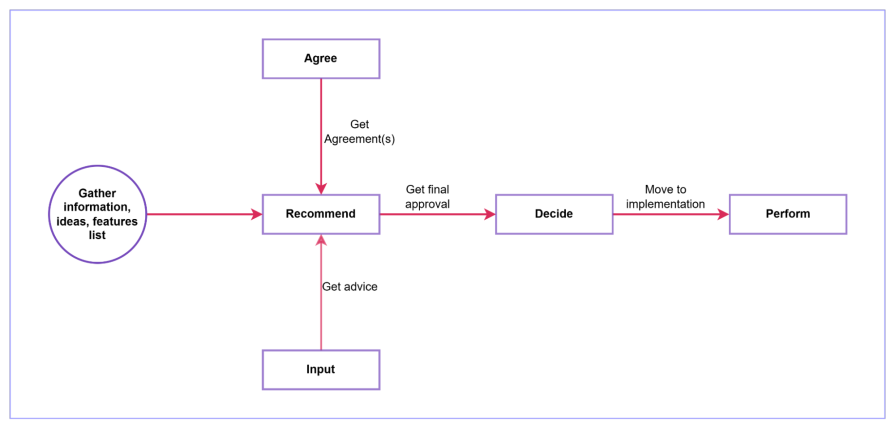As a product manager, you find yourself involved in complex, cross-functional projects with multiple stakeholders. In order to be successful, you need to have clarity on roles, responsibilities, and communication. Ambiguities cause conflicts, add delays, reduce accountability, and slow down growth.

The good news is you can lean on popular role-definition frameworks like RACI, RAPID, and RASIC to take a structured approach to assigning roles and clarifying accountability, ensuring projects run smoothly and efficiently. These frameworks empower you to streamline decision-making, enhance project execution, and foster effective collaboration among stakeholders.
Each framework has unique characteristics and use cases. This article unpacks RACI, RAPID, and RASIC to help you understand which one to choose for your next project.
RACI is a widely used role-definition framework in project management, designed to clarify roles, ensure accountability, and streamline communication. RACI stands for responsible, accountable, consulted, and informed, and each represents a specific role in the execution and management of a task or project:
An example chart might look something like this:
| Tasks / deliverables | Andy (PM) | John (Dev) | Sarah (QA) | Mike (Architect) | Alex (UX Designer) | Elon (VP) |
| Vendor cart requirements analysis | R, A | C | I | C | C | I |
| UX design and finalization | A | I | I | C | R | I |
| Test cases development | A | C | R | I | C | I |
| Coding and unit testing | A | R | I | C | C | I |
| QA validation and sign-off | A | A | R | I | I | I |
| Demo to customer and buy-in | I | I | I | I | I | R, A |
To implement the RACI framework follow these steps:
Although RACI can be a great framework, it does some with its own set of limitations:
RAPID helps clarify roles and streamline organizational decision-making processes. Unlike task management frameworks, RAPID is specifically designed to identify who makes decisions, who provides input, and who implements them.
RAPID reduces ambiguity, accelerates decision timelines, and improves accountability. RAPID stands for recommend, agree, perform, input, and decide each representing a specific function in the decision-making process:

Example: Develop a feature “Vendor Cart” in an existing product.
| Role | Assignment | Responsibility |
| Recommend | Product manager | Analyze options, assess feasibility, and propose a new product feature |
| Agree | Engineering lead | Approve the technical feasibility of the proposed feature |
| Perform | Dev & QA teams | Implement and deliver the feature as per specifications |
| Input | Marketing manager, engineering head, sales team | Provide customer insights and market data to shape the recommendation |
| Decide | VP of product and engineering | Make the final decision on whether to proceed with the feature |
To implement the RAPID framework, use the following steps:
RAPID comes with limitations that are important to understand before making the decision to go with it:
This framework helps in defining clear roles and responsibilities for a project. Here, an additional *support *role is defined which helps divide task execution and delivery responsibilities:
A RASIC chart looks likes this:
| Tasks / deliverables | Andy (PM) | John (Dev) | Sarah (QA) | Mike (Architect) | Alex (UX Designer) | Elon (VP) |
| Vendor cart requirements analysis | R, A | C | I | C | C | I |
| UX design and finalization | A | I | I | C | R | I |
| Provide mockups to UI | A | R | I | I | S | I |
| Test cases development | A | C | R | I | C | I |
| Coding and unit testing | A | R | I | C | C | I |
| QA validation and sign-off | A | A | R | I | I | I |
| Demo to customer and buy-in | I | I | I | I | I | R, A |
| Onboard beta users manually | A | A | A | I | S | I |
To implement the RASIC framework, follow these steps:
When it comes to the RASIC framework, keep these limitations in mind:
This comparison table highlights the key differences, use cases, strengths, and limitations for RACI, RAPID, and RASIC frameworks:
| Aspect | RACI | RAPID | RASIC |
| Primary area of focus | Task management: Clarifying task roles and responsibilities | Decision-making process: Clarifying decision ownership | Task management: Clarifying task roles with added support for resource-intensive projects |
| Use case | Projects requiring accountability and clear communication | High-stakes projects with multiple contributors in decision-making | Projects requiring additional roles for support or involving resource-sharing |
| Roles defined | – Responsible (R)
– Accountable (A) – Consulted (C) – Informed (I) |
– Recommend (R)
– Agree (A) – Perform (P) – Input (I) – Decide (D) |
– Responsible (R)
– Approve (A) – Support (S) – Inform (I) – Consult (C) |
| Decision ownership | Shared across roles | Centralized to the “decide” role | Shared. Complete emphasis on task execution and support |
| Task complexity | Suitable for standard project management | Best for strategic or complex decision-making processes | Ideal for task-heavy or collaborative projects |
| Strengths | Provides clarity in roles reducing task ambiguity and ensuring accountability | Encourages structured decision-making and eliminates bottlenecks avoiding delay in process | Enhances collaboration with a “support” role which is useful for cross-functional teams |
| Limitations | Doesn’t focus on decision-making and is inflexible in fast-changing environments due to rigid structure | Complex and time-consuming to implement and requires strong communication | Along with RACI limitations, adds complexity if support roles are not well-defined |
| Appropriate team size | Small to medium teams | Medium to large teams with decision-making challenges | Medium to large teams with task collaboration needs |
| Example | Assigning roles in a product development lifecycle | Deciding whether to launch a new subscription model | Developing a new website with support from cross-functional teams |
No hard rule suggests you should use any one of the frameworks in any given situation. Use the one that makes the most sense for your specific project and team dynamic:
| Framework | When to use |
| RACI |
|
| RAPID |
|
| RASIC |
|
Defining clear roles and responsibilities is foundational to successful project management, especially in complex, cross-functional, and multi-stakeholder environments. RACI, RAPID, and RASIC are powerful frameworks that help define roles and responsibilities for task management, offer clear decision-making processes to avoid ambiguities and delays, and create a collaborative environment that ensures smoother execution and delivery.
As a final takeaway:
Featured image source: IconScout

LogRocket identifies friction points in the user experience so you can make informed decisions about product and design changes that must happen to hit your goals.
With LogRocket, you can understand the scope of the issues affecting your product and prioritize the changes that need to be made. LogRocket simplifies workflows by allowing Engineering, Product, UX, and Design teams to work from the same data as you, eliminating any confusion about what needs to be done.
Get your teams on the same page — try LogRocket today.

A practical guide for PMs who want to stop being bottlenecks, delegate smarter, and lead teams effectively with a clear ownership framework.

Stop letting unreliable data block features. Treat data as inventory to track quality, ownership, and ship with confidence.

Learn why slide decks slow teams down and explore better tools like whiteboards, PRDs, and prototypes to improve collaboration and alignment.

AI PM roles are evolving fast. Learn the five types of AI PMs, the skills they need, and how they shape AI products across industries.